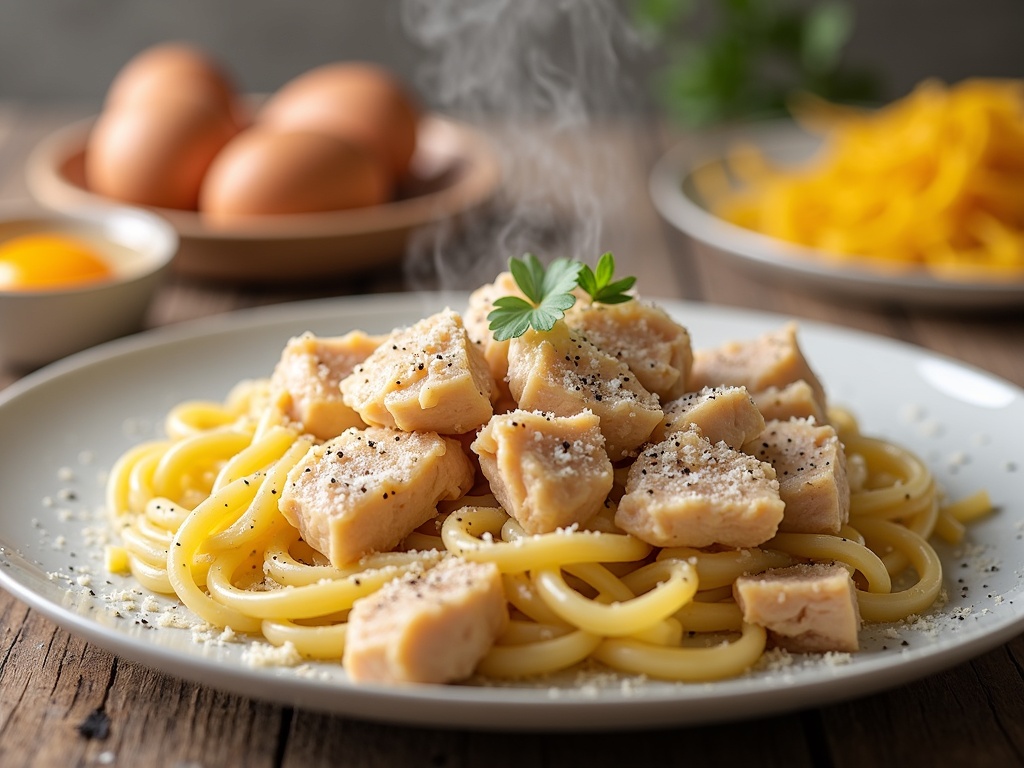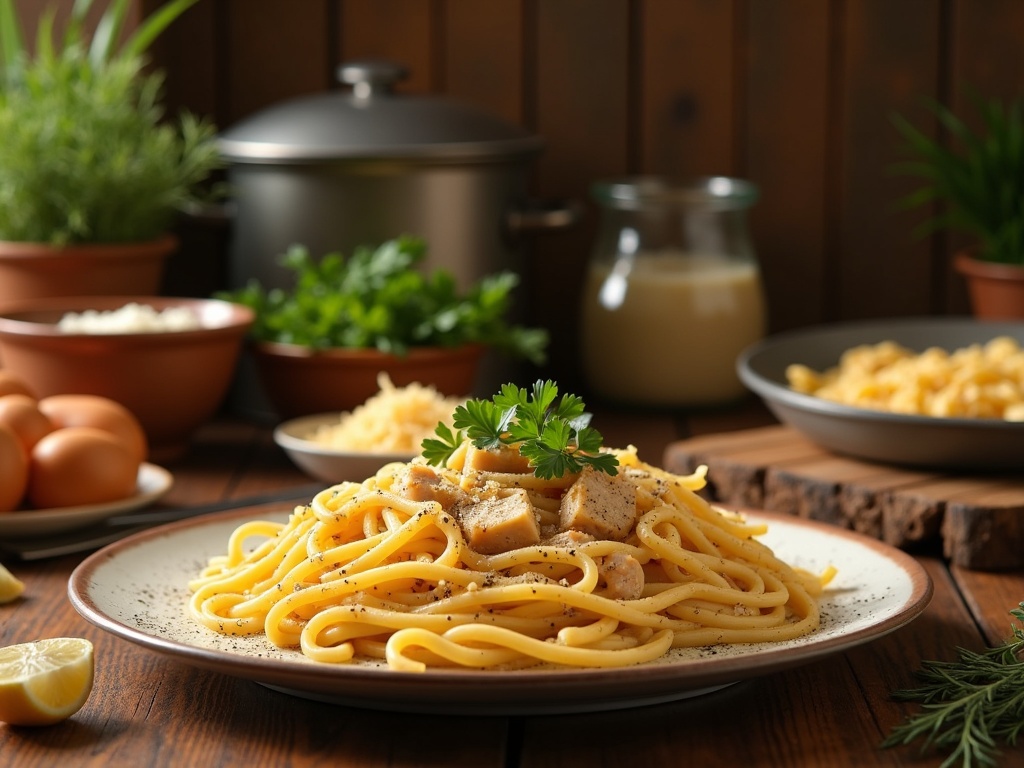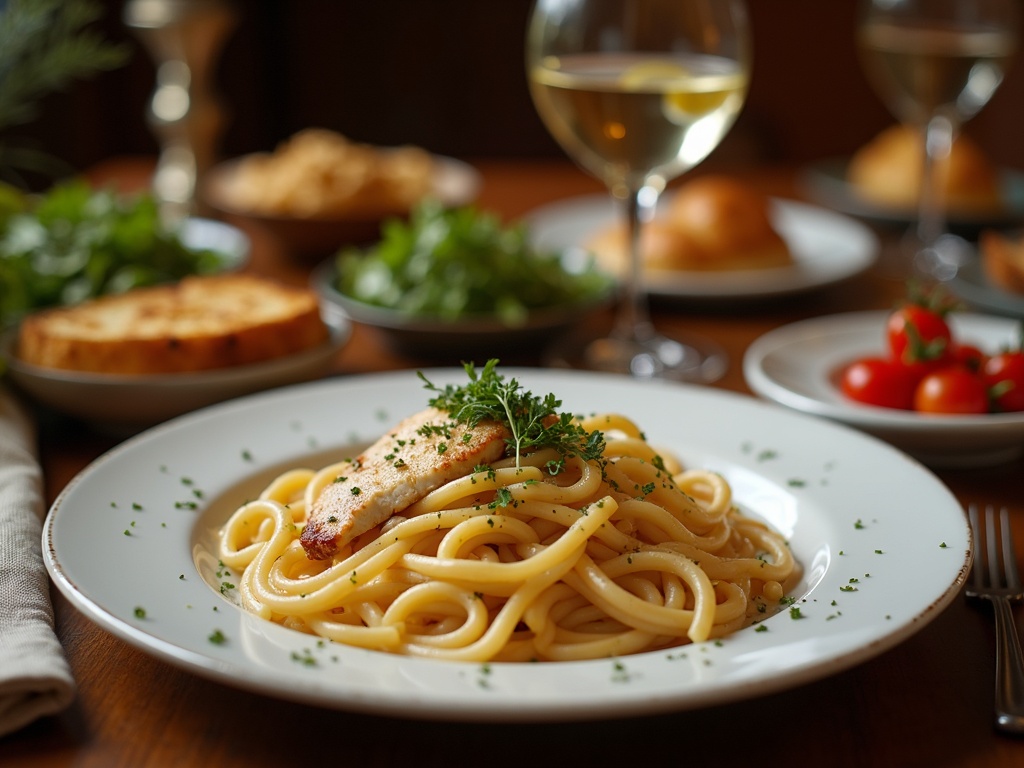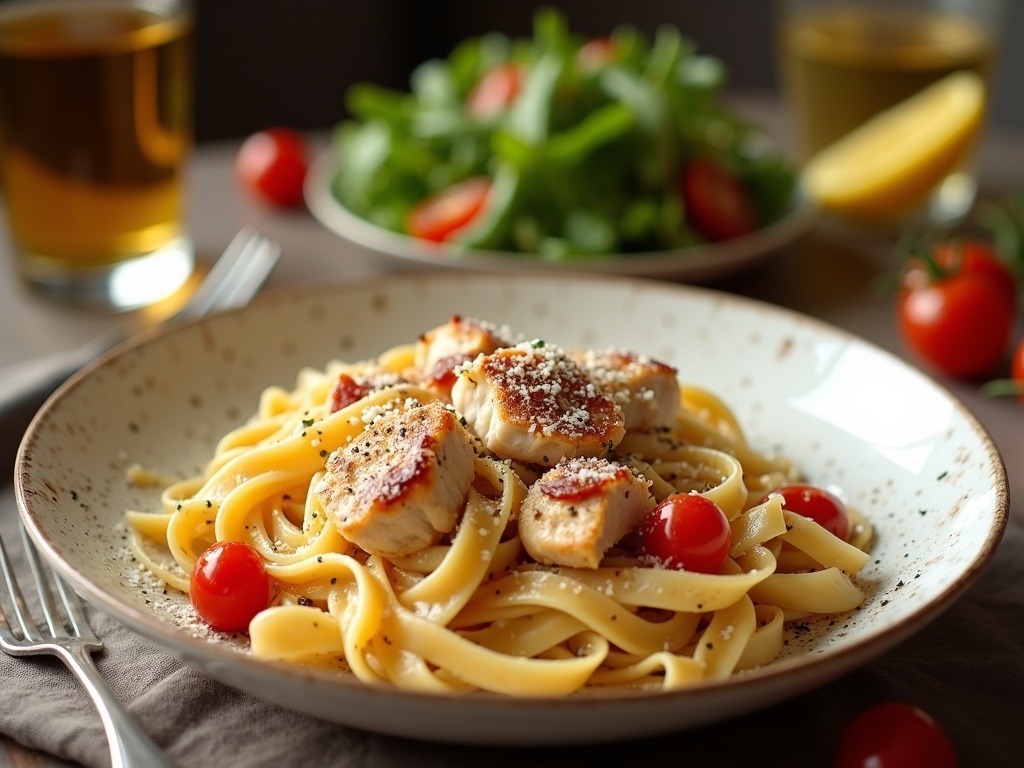Chicken carbonara recipe transforms simple ingredients into an exceptional dining experience. This Italian classic combines a creamy egg-based sauce, savory chicken, and al dente pasta into a dish that balances rich flavors with straightforward preparation.
Find In This Article
Key Takeaways
- The authentic carbonara sauce relies on eggs and cheese rather than cream, with pasta water being essential for creating the perfect silky texture.
- Quality ingredients matter significantly – use freshly grated parmesan, room temperature eggs, and properly rendered pancetta or bacon for best results.
- The entire dish can be prepared in approximately 30 minutes, making it ideal for weeknight dinners that still feel special.
- Chicken carbonara offers balanced nutrition with complete proteins, B vitamins, calcium, and complex carbohydrates in a satisfying meal.
- Proper storage in airtight glass containers keeps leftovers fresh for up to three days, with gentle reheating techniques preserving the sauce’s creamy consistency.
Everything You Need for the Perfect Chicken Carbonara Recipe
Creating a delicious chicken carbonara at home requires just a handful of quality ingredients that work together to create that signature creamy, savory flavor. I’ve prepared countless Italian dishes over the years, and carbonara remains one of my favorites for its simplicity and impact.
Essential Ingredients and Nutritional Information
First, you’ll need these key components to serve 4 people:
- 1 pound chicken breast, cut into bite-sized pieces
- 8 ounces spaghetti or fettuccine (about half a standard package)
- 2 large eggs at room temperature
- 1 cup freshly grated parmesan cheese (pre-grated won’t melt properly)
- 4 ounces pancetta or turkey bacon, diced
- 2 cloves garlic, minced
- Freshly ground black pepper and salt to taste
- Optional fresh parsley for garnish
Each serving of this satisfying chicken carbonara contains approximately 600 calories with 30g protein, 35g carbs, and 28g fat, making it a balanced meal option when paired with a simple side salad.
The magic of carbonara happens when hot pasta meets raw eggs to create a silky sauce without scrambling. I find this technique similar to the one used in creamy pasta dishes, though carbonara doesn’t use actual cream.
Quality matters with these ingredients. Freshly grated parmesan cheese melts more smoothly than pre-packaged versions, and using free-range eggs gives the sauce a richer color and flavor. If you enjoy cream-based pastas, you might also like white sauce pasta or chicken lasagna for similar comfort food experiences.
For those looking to add vegetables, I sometimes incorporate peas or asparagus. If you prefer a different flavor profile entirely, try broccoli pasta or the boldly flavored puttanesca recipe as alternatives.

Master the Classic Carbonara Sauce
Creating an authentic carbonara sauce is all about embracing traditional Italian techniques that deliver incredible flavor without relying on cream. I’ve perfected this approach over the years and can confirm that the magic of a true carbonara lies in its simplicity – eggs, cheese, and a careful technique are all you need for silky perfection.
Creating the Perfect Emulsion
The secret to a luxurious creamy pasta sauce isn’t adding heavy cream (a common mistake), but mastering emulsification. I start by whisking egg yolks with finely grated Pecorino Romano and Parmigiano-Reggiano cheese in a bowl large enough to toss your pasta in. This mixture forms the foundation of your sauce.
To prevent the eggs from scrambling when they meet hot pasta, I follow these critical steps:
- Allow the egg-cheese mixture to come to room temperature before using
- Remove the pasta pot from heat for at least 30 seconds before adding pasta to the egg mixture
- Toss continuously and vigorously once pasta meets eggs to distribute heat evenly
- Add pasta water gradually rather than all at once to control temperature
The pasta water is absolutely essential for achieving the perfect consistency. I reserve at least 1 cup before draining my pasta, as the starchy water helps the sauce cling to the pasta while creating that silky texture that defines a great Italian dish.
Timing is everything when making carbonara. I prepare my egg mixture while the pasta cooks, then immediately combine them when the pasta is al dente. This synchronization ensures the pasta’s residual heat gently cooks the eggs without scrambling them. The transformation happens in seconds – watch as the sauce changes from liquid to a velvety coating that hugs every strand of pasta.
I’ve learned through experience that using a warm (not hot) bowl helps maintain the ideal temperature. Sometimes I’ll even warm my serving bowl with hot water, then dry it before adding my egg mixture. This prevents the sauce from cooling too quickly when the pasta is added.
For an authentic chicken carbonara, I cook the chicken separately, seasoning it well, then toss it with the pasta at the very end. This approach ensures the meat doesn’t interfere with the delicate sauce-making process. The chicken adds substance to the dish while the white sauce maintains its integrity.
The traditional preparation calls for guanciale (cured pork jowl), but pancetta or even thick-cut bacon makes a fine substitute when cooking at home. I render the fat slowly to extract maximum flavor, then toss the crispy bits with the final dish. This adds a wonderful textural contrast to the silky pasta.
When making broccoli pasta variations of carbonara, I blanch the broccoli in the pasta water just before the pasta finishes cooking. This adds vibrant color and nutrition while maintaining the authentic sauce technique.
For those looking to expand their pasta recipe collection, mastering carbonara first provides an excellent foundation for understanding the art of pasta sauces. Once you’ve conquered this classic, you’ll find the confidence to tackle everything from chicken lasagna to more complex preparations.
The beauty of carbonara lies in its elegant simplicity. When made properly, it showcases how just a few quality ingredients – eggs, cheese, pasta, and cured meat – can transform into something greater than the sum of their parts. This is what Italian cooking is all about.
Quick and Easy Preparation Guide
Making authentic Italian chicken carbonara doesn’t need to be complicated. I’ve broken down this recipe into simple steps that’ll have you enjoying this creamy pasta dish in just 30 minutes from start to finish.
Step-by-Step Process
Start by bringing a large pot of salted water to a boil for your pasta. While waiting for the water to boil, cut your chicken breasts into bite-sized pieces and season with salt and pepper. When the water is ready, add your pasta and cook for 8-10 minutes until al dente.
Meanwhile, heat olive oil in a large skillet over medium-high heat. Add the chicken pieces and cook for 5-7 minutes per side until golden brown and cooked through. Remove the chicken and set aside.
The sauce comes together quickly in about 10 minutes. In the same skillet, add minced garlic and cook until fragrant. Then, in a separate bowl, whisk together eggs, grated Parmesan cheese, and black pepper. This will be the base of your creamy sauce.
When the pasta is done, reserve about 1/2 cup of pasta water before draining. Add the hot pasta directly to the skillet with garlic, then quickly toss in the egg mixture. The heat from the pasta will cook the eggs creating a silky sauce. If it’s too thick, add a splash of the reserved pasta water.
For perfect al dente pasta, remember these tips:
- Always salt your pasta water generously
- Start testing the pasta 2 minutes before the package says it’s done
- The pasta should have a slight bite to it – not crunchy but not mushy
- Drain immediately when ready, as it continues cooking even after draining
Finally, add the cooked chicken back to the skillet and toss everything together. For extra richness, I like to add a bit of cream to my creamy pasta carbonara, though this is optional for purists.
A final sprinkle of Parmesan cheese, fresh black pepper, and chopped parsley completes this delicious pasta dish that’s perfect for weeknight dinners when time is tight but you still want something impressive.

Health Benefits and Nutrition
The classic Italian chicken carbonara isn’t just delicious—it’s packed with impressive nutritional value too. I’ve found that incorporating this dish into a balanced diet offers numerous health benefits worth exploring.
Protein Powerhouse
Chicken carbonara delivers a complete protein source thanks to its star ingredient. The chicken provides all nine essential amino acids your body needs but can’t produce on its own. This makes the dish particularly valuable for muscle maintenance and repair.
Beyond just protein, carbonara contains several vital nutrients:
- Vitamin B from both chicken and egg components, supporting energy metabolism
- Calcium from the cheese, essential for bone health
- Iron primarily from the chicken, helping with oxygen transport
- Zinc that supports immune function and wound healing
What makes carbonara nutritionally attractive is its balanced macronutrient profile. I appreciate how the protein from chicken pairs with energy-providing carbohydrates from the pasta and healthy fats from olive oil and cheese.
System Support Benefits
Garlic, a key flavor component in authentic creamy pasta recipes, brings more than just taste. It contains compounds like allicin that promote heart health by potentially helping regulate blood pressure and cholesterol levels.
The immune system also gets support from several carbonara ingredients. The protein from chicken helps build antibodies, while garlic provides antimicrobial properties. The vitamin content further assists immune function, making white sauce pasta variations a comfort food with actual comforting benefits.
The carbohydrates in pasta deserve special mention. Unlike simple sugars, pasta provides complex carbohydrates that release energy gradually, helping maintain steady blood sugar levels. This makes carbonara particularly satisfying, especially when made with broccoli pasta for added fiber and nutrients.
For those looking to enhance the nutritional profile even further, consider adding vegetables like peas or asparagus. These additions complement the dish beautifully while increasing the vitamin and mineral content. I’ve found that chicken lasagna follows similar principles of balanced nutrition when prepared thoughtfully.
When prepared with moderate portions of cheese and quality ingredients, chicken carbonara can be part of a nutrient-dense eating pattern that satisfies both taste buds and nutritional needs. The key lies in mindful preparation and serving sizes, allowing you to enjoy this Italian classic without compromising your health goals.
Perfect Pairings and Serving Ideas
Elegant Accompaniments for Your Carbonara
I’ve found that chicken carbonara tastes even better with thoughtfully chosen accompaniments. A glass of juice pairs wonderfully with this dish – try apple or grape juice for a refreshing contrast that cuts through the creamy richness of the sauce. For non-alcoholic options, sparkling water with a squeeze of lemon provides a cleansing effect between bites.
A simple side salad makes the perfect companion to creamy pasta dishes like carbonara. I recommend a peppery arugula salad dressed lightly with good quality olive oil and a splash of balsamic vinegar. The slight bitterness of the greens balances the creamy sauce beautifully.
Cherry tomatoes add a burst of color and freshness to your plate. I like to halve them and toss them with a little olive oil, salt, and pepper before serving alongside the pasta. Their acidity cuts through the richness of the white sauce pasta, creating a perfect flavor balance.
For garnishing, fresh parsley is a must. Chopped finely and sprinkled just before serving, it adds a pop of color and fresh herbaceous notes that elevate the entire dish. This simple touch makes a remarkable difference in both presentation and flavor.
Serving temperature matters tremendously with carbonara. I serve it immediately after tossing the pasta with the sauce to maintain the perfect creamy consistency. Wait too long, and the eggs might solidify too much or the pasta could become sticky.
For restaurant-style plating, I use tongs to create a tall twist of pasta in the center of a warmed plate. This technique, often used for Italian dishes, creates height and visual appeal. Top with extra freshly ground black pepper, a sprinkle of grated cheese, and your parsley garnish.
Consider serving garlic bread on the side for an extra indulgent meal, or keep it lighter with grilled vegetables. For a complete experience, follow your carbonara with a light dessert like fresh berries with a touch of honey – the perfect way to end a meal centered around this rich and satisfying chicken pasta dish.

Storage and Leftover Tips
Storing leftover chicken carbonara properly ensures you can enjoy this creamy dish for days after preparation. I’ve found that carbonara stays fresh in the refrigerator for up to 3 days when stored correctly, though it’s always best enjoyed as soon as possible after cooking.
Best Storage Practices
When storing carbonara, the container you choose makes a significant difference. I recommend using airtight glass containers rather than plastic ones, as they won’t absorb the garlicky aroma or develop stains from the sauce. Make sure the pasta has cooled completely before transferring it to storage—this prevents condensation that can make your pasta soggy.
For optimal freshness, follow these simple guidelines:
- Allow the pasta to cool for no more than 2 hours at room temperature
- Transfer to an airtight container, leaving minimal air space
- Label with the date to track freshness
- Store on refrigerator shelves rather than in the door where temperatures fluctuate
Reheating for Maximum Flavor
Reheating carbonara sauce requires a bit of care to restore its silky texture. The egg-based sauce tends to thicken significantly when cold, so adding a splash of liquid is essential. I add 1-2 tablespoons of chicken broth, milk, or cream per serving when reheating to revive the sauce’s creaminess.
The stovetop method yields the best results for reheating. Place your carbonara in a non-stick pan over medium-low heat, add your liquid of choice, and stir gently until warmed through. This typically takes 4-5 minutes. Avoid high heat, which can cause the eggs in the sauce to scramble.
If you’re in a hurry, microwave reheating works too—cover the container with a damp paper towel, use 50% power, and stir every 30 seconds until heated thoroughly. This gentle approach helps maintain the sauce consistency better than full-power heating.
For food safety, always ensure Italian pasta dishes reach 165°F (74°C) when reheating. The chicken component in carbonara makes this especially important, as poultry requires thorough reheating to eliminate any potential bacteria that may have developed during storage.
With these simple storage and reheating techniques, your chicken pasta leftovers will taste nearly as delicious as when freshly made!
Sources:
Classic Carbonara Recipe. The New York Times Cooking, 2022
Nutritional Information for Pasta. USDA FoodData Central, 2023
Cooking Techniques for Italian Dishes. Italian Cooking School, 2023

